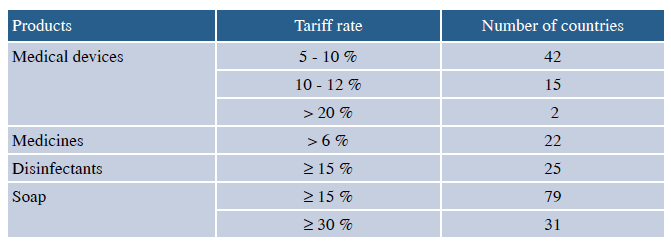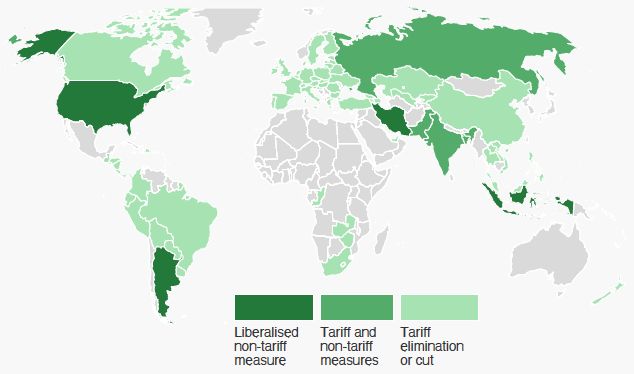It is not unreasonable to ask, in the current crisis triggered by COVID-19, if we are not all too dependent on some vital supplies from other countries. It may not be a wise strategy to put so many eggs in the same basket. Diversification of production ensures better security of supply and safe delivery. This strategy may include some reshoring by firms around the world. However, as we argue in our contribution (Stellinger et al. 2020) to the recent VoxEU eBook on Covid-19 and trade policy (Baldwin and Evenett 2020), it would be dangerous to suggest that countries should radically reduce their dependency on imports and embark on a path towards deglobalisation.
COVID-19 and Trade Policy: Why Turning Inward Won't Work, co-edited by Richard Baldwin and Simon J. Evenett. Download it for free here.
In fact, only an open market, welcoming imports, can provide consumers with a variety of quality goods and services at competitive prices. This openness is important also for the sake of public health – both to the immediate crisis but also to the long-term health prospects of people throughout the world.
Multinationals in the medical supplies and pharma sectors have split up the production process – from R&D, manufacturing of components and assembly of final goods to distribution, marketing, sales, maintenance, and so on – efficiently across countries with different comparative advantages. Whereas most R&D is carried out in the US and the EU, much of manufacturing takes place in China and countries such as Mexico, Singapore, Costa Rica, the Dominican Republic and Malaysia. In those countries, medical clusters have emerged as a result. A positive outcome is worldwide avaliability of reasonable priced and qualititative pharmaceutical products as well as products such as soap, gloves, disinfectants, respirators and state-of-the-art x-ray machines.
The cost containment resulting from this division of labour is essential to finance large-scale health programmes. Many countries face a growing demographic challenge. Increase in life expectancy is a positive thing, but ageing populations are also a great economic challenge. As for developing countries, there are great aspirations for better public health, but often limited resources. Anyone arguing against the role of trade in public health argues in favour of inefficiency and thus higher costs.
But it is not just a matter of costs. It is obvious that one country alone can not manufacture all the medical technology, the chemical inputs used for medicines, or innovate to create all essential vaccines. Even if one country could do it on its own, it would not be the safest way to make sure everyone has access to these vital products. Risk spreading is a superior strategy.
Another strong contribution of trade to public health is that without trade, some vital medicines and medical technology would simply not exist. These products require very large investments in R&D, and those investments would not be profitable if firms investing could not export to the world. Reduced trade opportunities will reduce innovation and thereby reduce access to health-related products.
Protectionism in the pharma and medical supplies sectors
Hence, for the sake of a safe and reasonably priced supply of medicines and medical supplies, open borders are needed. That is not to say that trade should be unregulated. These sectors are tightly regulated and rightly so. A vast array of regulations, laws, tests and mandatory procedures ensure effectivness and patient safety. Unfortunately, on top of the necessary non-tariff measures there are also unnecessary non-tariff measures in place to protect domestic industry rather than patients – such as import bans, licensing requirements and ‘buy national’ public procurement requirements.
There are also many WTO countries that, at least before the crisis, charged high tariffs on medical devices, medicines, disinfectants and soap. See Table 1 for some examples.
Table 1
Source: WTO Tariff Download facility.
Many countries have also introduced export barriers, or even export bans, on protective equipment and medical equipment during the crisis. This has even happened within the European Single Market. It is done in a vain attempt, in the fight against the virus, to keep certain products within a country, but such actions ignore global value chains and create bottlenecks for production by locking inputs within countries. Even temporary export bans risk generating mistrust, destroying trade relations, and can create a protectionist spiral that leads to a further escalation of export bans. It leaves developing countries at particular risk.
Removing protectionism in the face of crisis
These trade barriers limit access to critial products. Liberalising trade in medicines and medicial supplies can thus help save lives. Unilaterally eliminating tariffs on these products is the quickest and easiest available tool.
The positive news is that many countries have taken this opportunity to act. Governments that have reduced or removed tariffs on medical supplies include examples as diverse as China, the EU and Bangladesh.
Some countries have also taken steps to reduce non-tariff barriers, such as Iran, which has removed an import ban on ethanol used to produce sanitizers and disinfectants, and Argentina, which has simplified the import clearance process of certain critical sanitary supplies. In the EU, use of the otherwise mandatory CE-marking has been temporariliy abolished (provided health and safety levels are maintained).
As of 19 April, all in all, 77 nations have reduced import barriers on medicines and medical supplies, as can been seen Figure 1. However, a range of mostly African countries have not yet implemented any liberalisation measures.
Figure 1 77 Nations have cut import barriers to COVID-19 medical supplies and medicines this year
Source: Global Trade Alert, 12 April 2020.
In addition to unilateral actions, some coordinated response among countries are taking place. A group of seven countries – New Zealand, Singapore, Canada, Australia, Chile, Brunei and Myanmar – committed in a statement at the end of March1 to keep supply chains open and remove any existing trade restrictive measures on essential goods, especially medical supplies. A few days after, the G20 countries issued a ministerial statement2 where they promise to work to ensure the flow of vital medical supplies and equipment.
European Commissioner for Trade, Phil Hogan, has proposed a less immediate and more long-term solution for reinforced global preparedness for future crises. In a meeting of EU trade ministers Hogan stated that the “international community” should launch “a comprehensive negotiation of a plurilateral agreement that would lead to a level playing field, including the possible permanent liberalisation of tariffs on medical equipment”.3
All of these initiatives are positive, but more action is needed by governments to ensure that trade policy can contribute to its fullest potential in tackling the crisis and to public health.
What more can countries do?
Beyond unilateral tariff reductions and removal of unneccesary non-tariff bariers on medicines and medical supplies, there are several additional measures that can be taken by governments, alone or collectively, to facilitate trade in these products.
Governments should design measures to cope with future emergencies. This could include trade-faciliation measures, where countries could explore the possibility to develop coordinated emergency programmes for relevant agencies to speed up the clearance and release of critical goods in times of crises. Governments could also develop programmes ensuring that people with key competences – such as medical staff and technical experts – can cross borders safely when needed.
Moreover, international cooperation and collective measures are needed to make the unilateral temporary measures to liberalise trade in medicines and medical supplies permanent. A plurilateral agreement among as many countries as possible to liberalise trade in medicines and medical supplies should be negotiated. Such an agreement could build on the WTO Pharmaceutical Tariff Elimination Agreement,4 signed in 1994, which abolished tariffs for finished pharmaceutical products and certain ingredients and components used to make pharmaceuticals.
However, the agreement needs to be updated with new products as it has not kept pace with the rapid product development in this innovative sector. It also needs to be expanded beyond pharmaceutical products. Medicial devices and personal protective equipment should be included in the agreement. The agreement also needs to be expanded in terms of participating countries. Many large countries, such as Brazil, China, India and Russia, have not signed on to this initiative. Also smaller developing nations, not least LDCs, need to be incentivised to join. Developed countries could therefore start to explore the possibilities to provide aid to fill in some of the budget gaps resulting from tariffs cuts in particular for LDCs.
To conclude, trade in medicines and medical supplies is not the problem but part of the solution, both to the immidiate crisis and the long term health challenges facing the world. Although risk spreading may be needed, we should not abandon the basic idea of a global division of labour based on comparative advantages. On the contary, measures should be taken to protect and strengthen the global value chains so that they can continue to deliver a safe and cost-efficient supply of medicines and medical supplies to the world.
References
Baldwin, R and S J Evenett (eds) (2020), COVID-19 and Trade Policy: Why Turning Inward Won’t Work, A VoxEU.org eBook, CEPR Press.
Stellinger, A, I Berglund and H Isakson (2020), “How trade can fight the pandemic and contribute to global health”, in R Baldwin and S J Evenett (eds) (2020), COVID-19 and Trade Policy: Why Turning Inward Won’t Work, A VoxEU.org eBook, CEPR Press.
Endnotes
https://www.trademinister.gov.au/minister/simon-birmingham/media-release...
https://www.wto.org/english/news_e/news20_e/dgra_30mar20_e.pdf
https://ec.europa.eu/commission/commissioners/2019-2024/hogan/announceme...
https://www.wto.org/gatt_docs/English/SULPDF/91770009.pdf








